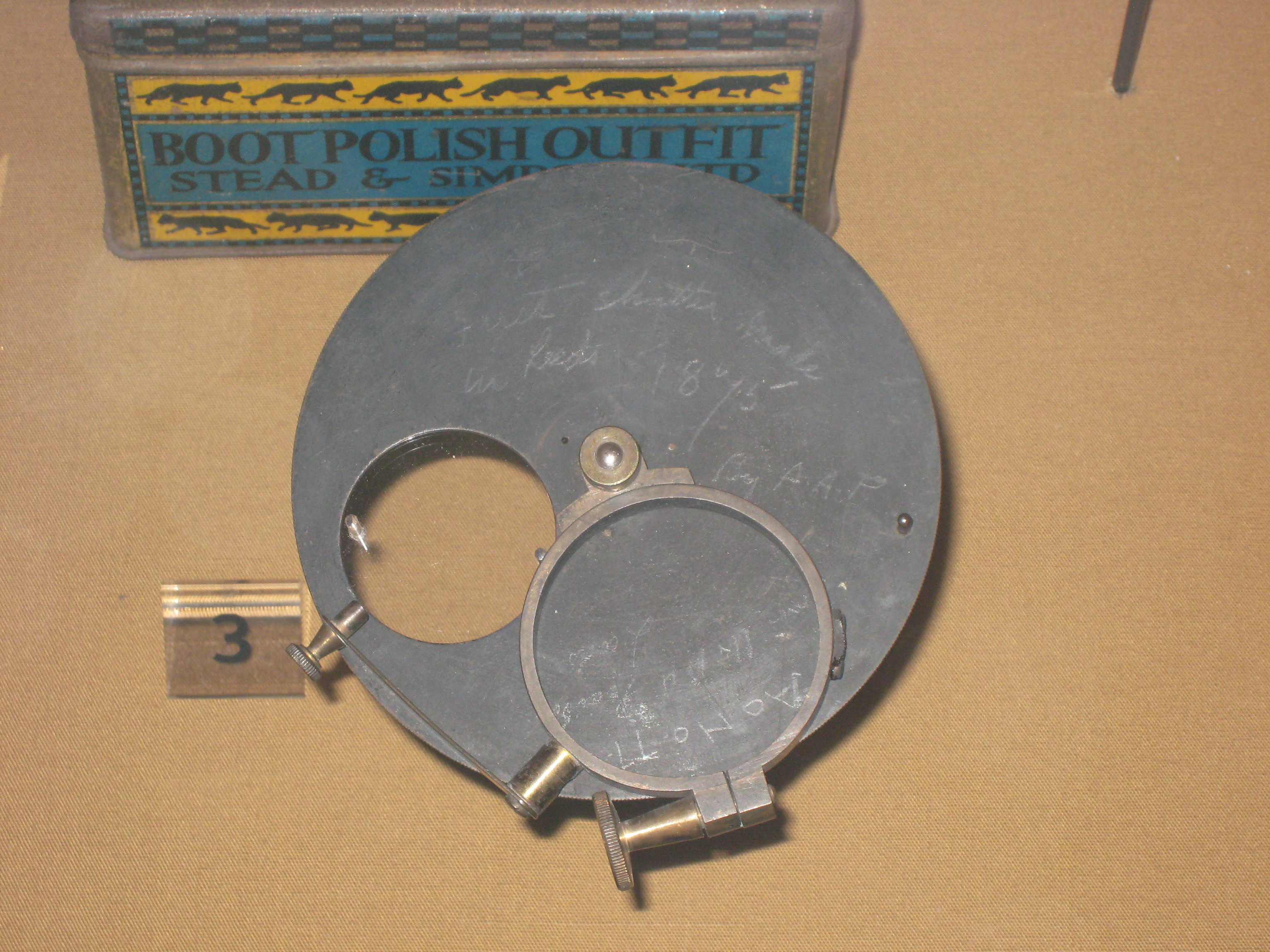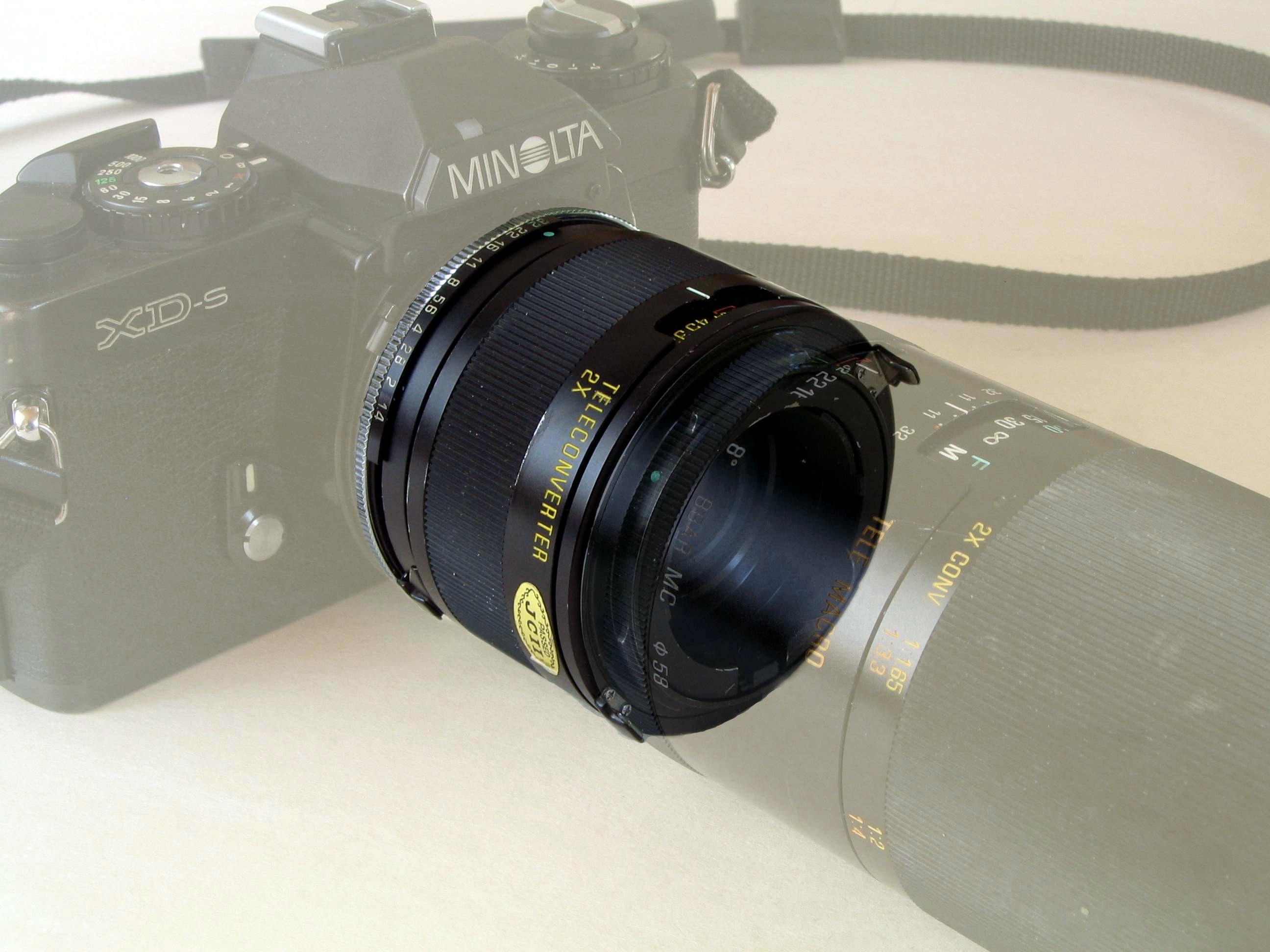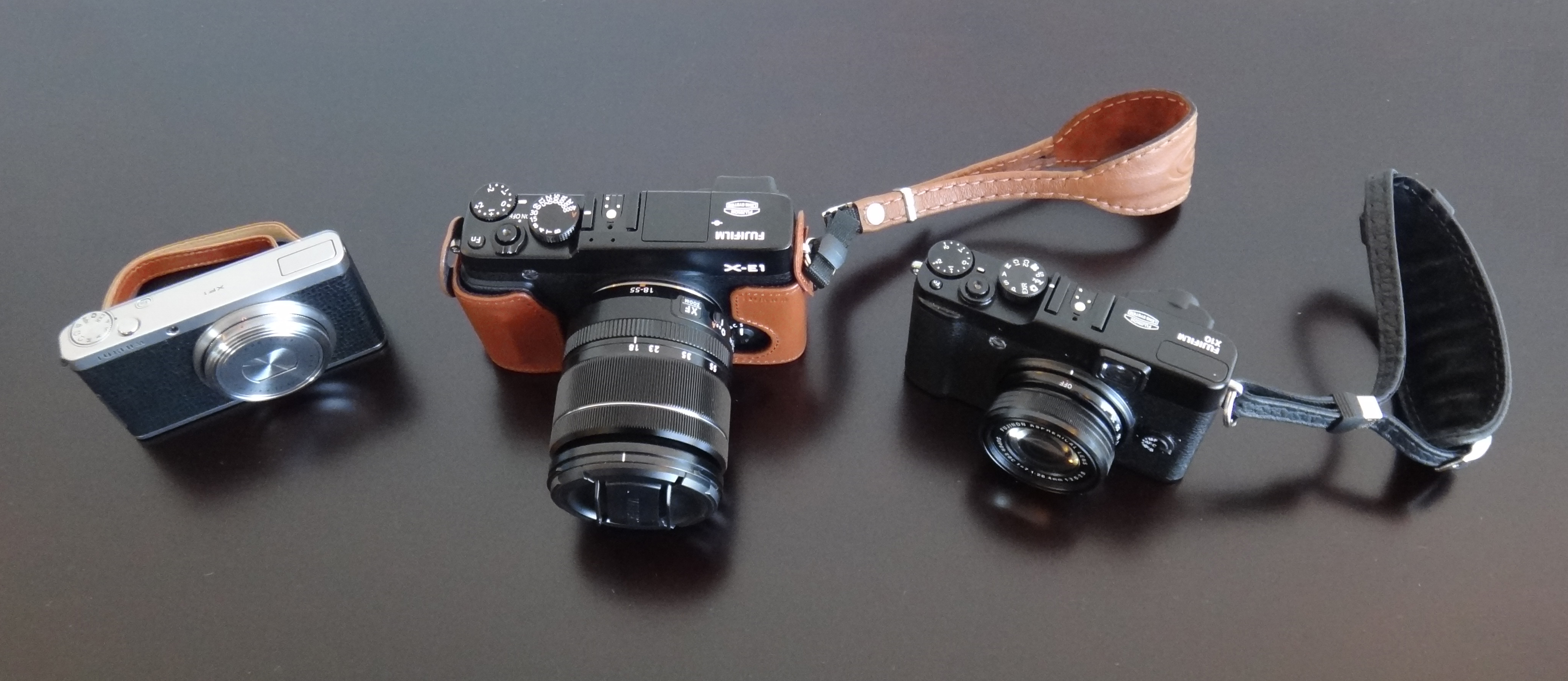|
Fujifilm X70
The Fujifilm X70 is an APS-C sensor digital compact camera with an 18.5 mm fixed prime lens (28 mm equivalent angle of view ( AOV) in 35 mm full frame format). It is part of Fujifilm's X-Series of cameras. It was announced in January 2016 (along with the Fujifilm X-Pro2) and was released on 18 February 2016. Comparison with other Fujifilm cameras Reviewers have noted the X70's similarity to the Fujifilm X100T and to the Ricoh GR II. The X70 combines an X-Trans CMOS II sensor with an EXR processor II, and is the smallest of Fujifilm's cameras to be equipped with the company's APS-C sensor. It shares some technology with the Fujifilm X100T (its sensor and auto focus system) but has a wider angle lens with a slower aperture, is smaller, lacks a built in viewfinder and has a tilting and fully upwards articulating touchscreen display. Key features *16.3 megapixel, APS-C sized X-Trans CMOS II sensor *Tilting and fully upwards articulating touchscreen display *Digital te ... [...More Info...] [...Related Items...] OR: [Wikipedia] [Google] [Baidu] |
Fujifilm
, trading as Fujifilm, or simply Fuji, is a Japanese multinational conglomerate headquartered in Tokyo, Japan, operating in the realms of photography, optics, office and medical electronics, biotechnology, and chemicals. The offerings from the company that started as a manufacturer of photographic films, which it still produces, include: document solutions, medical imaging and diagnostics equipment, cosmetics, pharmaceutical drugs, regenerative medicine, stem cells, biologics manufacturing, magnetic tape data storage, optical films for flat-panel displays, optical devices, photocopiers and printers, digital cameras, color films, color paper, photofinishing and graphic arts equipment and materials. Fujifilm is part of the Sumitomo Mitsui Financial Group financial conglomerate (''keiretsu''). History 20th century Fuji Photo Film Co., Ltd. was established in 1934 as a subsidiary of Daicel with the aim of producing photographic films. Over the following 10 years, the comp ... [...More Info...] [...Related Items...] OR: [Wikipedia] [Google] [Baidu] |
Gizmodo
''Gizmodo'' ( ) is a design, technology, science and science fiction website. It was originally launched as part of the Gawker Media network run by Nick Denton, and runs on the Kinja platform. ''Gizmodo'' also includes the subsite ''io9'', which focuses on science fiction and futurism. ''Gizmodo'' is now part of G/O Media, owned by private equity firm Great Hill Partners. History The blog, launched in 2002, was originally edited by Peter Rojas, who was later recruited by Weblogs, Inc. to launch their similar technology blog, ''Engadget''. By mid-2004, ''Gizmodo'' and ''Gawker'' together were bringing in revenue of approximately $6,500 per month. Gizmodo then launched in other locations: *In 2005, VNU and Gawker Media formed an alliance to republish ''Gizmodo'' across Europe, with VNU translating the content into French, German, Dutch, Spanish, Italian and Portuguese, and adding local European-interest material. *In 2006, ''Gizmodo Japan'' was launched by Mediagene, with add ... [...More Info...] [...Related Items...] OR: [Wikipedia] [Google] [Baidu] |
Hot Shoe
Canon EOS 350D Hot shoe Proprietary hot shoe used by Minolta and older Sony cameras (Konica Minolta Maxxum 7D">Sony.html" ;"title="Minolta and older Sony">Minolta and older Sony cameras (Konica Minolta Maxxum 7D) A hot shoe is a mounting point on the top of a camera to attach a flash (photography), flash unit and other compatible accessories. It takes the form of an angled metal bracket surrounding a metal contact point which completes an electrical connection between camera and accessory for standard, brand-independent flash synchronization. The hot shoe is a development of the standardised "accessory shoe", with no flash contacts, formerly fitted to cameras to hold accessories such as a rangefinder, or flash connected by a cable. The dimensions of the hot shoe are defined by the International Organization for Standardization in ISO 518:2006. Details such as trigger voltage are not standardised; electrical incompatibilities are still possible between brands. Design The h ... [...More Info...] [...Related Items...] OR: [Wikipedia] [Google] [Baidu] |
Shutter (photography)
In photography, a shutter is a device that allows light to pass for a determined period, exposing photographic film or a photosensitive digital sensor to light in order to capture a permanent image of a scene. A shutter can also be used to allow pulses of light to pass outwards, as seen in a movie projector or a signal lamp. A shutter of variable speed is used to control exposure time of the film. The shutter is constructed so that it automatically closes after a certain required time interval. The speed of the shutter is controlled by a ring outside the camera, on which various timings are marked. Camera shutter Camera shutters can be fitted in several positions: * Leaf shutters are usually fitted within a lens assembly (''central shutter''), or more rarely immediately behind (''behind-the-lens shutter'') or, even more rarely, in front of a lens, and shut off the beam of light where it is narrow. *Focal-plane shutters are mounted near the focal plane and move to uncover the fil ... [...More Info...] [...Related Items...] OR: [Wikipedia] [Google] [Baidu] |
Teleconverter
A teleconverter (sometimes called tele extender) is a secondary lens mounted between a camera and a photographic lens which enlarges the central part of an image obtained by the lens. For example, a 2× teleconverter for a 35 mm camera enlarges the central 12×18 mm part of an image to the size of 24×36 mm in the standard 35 mm film format. Teleconverters are typically made in 1.4×, 1.7×, 2× and 3× variants, with 1.4× and 2× being the most common. A 2× teleconverter doubles the apparent focal length of a given lens. Teleconverters also decrease the intensity of the light that reaches the film plane (or sensor) by the square of its magnification. A 2× teleconverter reduces the light to 1/4, doubles the focal ratio and halves the resolution of the master lens it is connected to. This, however, does not necessarily halve the resolution of the digital image. A closely related device reduces the focal length. It is generally marketed under the name speed ... [...More Info...] [...Related Items...] OR: [Wikipedia] [Google] [Baidu] |
Touchscreen
A touchscreen or touch screen is the assembly of both an input ('touch panel') and output ('display') device. The touch panel is normally layered on the top of an electronic visual display of an information processing system. The display is often an LCD, AMOLED or OLED display while the system is usually used in a laptop, tablet, or smartphone. A user can give input or control the information processing system through simple or multi-touch gestures by touching the screen with a special stylus or one or more fingers. Some touchscreens use ordinary or specially coated gloves to work while others may only work using a special stylus or pen. The user can use the touchscreen to react to what is displayed and, if the software allows, to control how it is displayed; for example, zooming to increase the text size. The touchscreen enables the user to interact directly with what is displayed, rather than using a mouse, touchpad, or other such devices (other than a stylus, which is opti ... [...More Info...] [...Related Items...] OR: [Wikipedia] [Google] [Baidu] |
Image Sensor
An image sensor or imager is a sensor that detects and conveys information used to make an image. It does so by converting the variable attenuation of light waves (as they pass through or reflect off objects) into signals, small bursts of current that convey the information. The waves can be light or other electromagnetic radiation. Image sensors are used in electronic imaging devices of both analog and digital types, which include digital cameras, camera modules, camera phones, optical mouse devices, medical imaging equipment, night vision equipment such as thermal imaging devices, radar, sonar, and others. As technology changes, electronic and digital imaging tends to replace chemical and analog imaging. The two main types of electronic image sensors are the charge-coupled device (CCD) and the active-pixel sensor (CMOS sensor). Both CCD and CMOS sensors are based on metal–oxide–semiconductor (MOS) technology, with CCDs based on MOS capacitors and CMOS sensors based on M ... [...More Info...] [...Related Items...] OR: [Wikipedia] [Google] [Baidu] |
Viewfinder
In photography, a viewfinder is what the photographer looks through to compose, and, in many cases, to focus the picture. Most viewfinders are separate, and suffer parallax, while the single-lens reflex camera lets the viewfinder use the main optical system. Viewfinders are used in many cameras of different types: still and movie, film, analog and digital. A zoom camera usually zooms its finder in sync with its lens, one exception being rangefinder cameras. History Before the development of microelectronics and electronic display devices, only optical viewfinders existed. Direct optical viewfinders Direct viewfinders are essentially miniature Galilean telescopes; the viewer's eye was placed at the back, and the scene viewed through the viewfinder optics. A declining minority of point and shoot cameras use them. Parallax error results from the viewfinder being offset from the lens axis, to point above and usually to one side of the lens. The error varies with distance, being ... [...More Info...] [...Related Items...] OR: [Wikipedia] [Google] [Baidu] |
Ricoh GR
The Ricoh GR is a digital large sensor compact camera announced by Ricoh on April 17, 2013, one of a number of Ricoh GR digital cameras. It was succeeded by the Ricoh GR II in 2015 and the Ricoh GR III in 2019. Ricoh GR Unlike its predecessors (the "GR Digital" series), the Ricoh GR incorporated an APS-C image sensor, while retaining a relatively compact form factor. Coupled with its retractable lens, the GR is potentially the slimmest of any camera in its class when powered off. Aside from portability, reviewers praised the GR for its lens quality and ergonomics. An unusual feature of the Ricoh GR was its built-in ND filter. Its maximum shutter speed was variable, depending on the aperture setting (ie, 1/4000s was only available at apertures smaller than 5.6). The Ricoh GR series has been compared against the Nikon Coolpix A and the Fujifilm X70, other large sensor compacts with the same fixed focal length (28mm). Ricoh GR II DPReview said that over the Ricoh GR, the GR II is ... [...More Info...] [...Related Items...] OR: [Wikipedia] [Google] [Baidu] |
Fujifilm X100
The Fujifilm X100 is a series of digital compact cameras with a fixed prime lens. Originally part of the FinePix line, then becoming a member of the X series from Fujifilm, the X100 series includes the FinePix X100, X100S, X100T, X100F, and X100V. They each have a large image sensor and a 23 mm lens (35 mm equivalent angle of view in full frame format). All five cameras have received generally positive reviews. The Fujifilm FinePix X100 was initially shown at the photokina show in September 2010 and was subsequently introduced in February 2011. It was the first model in the Fujifilm X-series of cameras and has since been joined by numerous models. It is superseded by the Fujifilm X100S. Fujifilm FinePix X100 The FinePix X100, the original model in the line, was introduced in 2011. This was the first camera in what would grow to become the Fujifilm X series although that designation came later. The X100 is a rangefinder-style camera. Key features * 12.3 MP, APS- ... [...More Info...] [...Related Items...] OR: [Wikipedia] [Google] [Baidu] |
Fujifilm X-Pro2
The Fujifilm X-Pro2 is a mirrorless interchangeable-lens digital camera announced in January 2016. It is part of Fujifilm's X-Series of cameras, the successor to the X-Pro1. Sales began on 3 March 2016. The X-Pro2 is the first mirrorless interchangeable-lens camera to have dual SD card slots. Fujifilm made some changes to the layout from the X-Pro1 and added a joystick. The X-Pro2 jointly won a Camera Grand Prix Japan 2016 Editors Award. The successor to the X-Pro2 is the Fujifilm X-Pro3 announced in October 2019. Features The Fujifilm X-Pro2 mirrorless camera is aimed at professional and ambitious amateur photographers. The camera body has a X mount for connecting Fujinon XF and XC lenses. The autofocus system works as a hybrid using contrast and phase detection, this allows focusing and release within 0.15 to 0.25 seconds from infinity to two meters. For manual focusing, a focus magnifier, a digital split image indicator as well as focus peaking are available to the use ... [...More Info...] [...Related Items...] OR: [Wikipedia] [Google] [Baidu] |
Fujifilm X-series
The Fujifilm X series is a line of digital cameras produced by Fujifilm. The series encompasses fixed lens and interchangeable lens mirrorless cameras and premium compact point-and-shoot cameras aimed at consumer, enthusiast and professional photographers. The X series is part of the larger Fujifilm FinePix, FinePix range of digital cameras from Fujifilm. The X series models use either APS-C or inch sensors. X series model lines Since its introduction with the X100 in 2011, the X series has grown to encompass a wide variety of designs. These lines can be broken out into the following categories or model lines. APS-C sensor The following lines are united by their use of APS-C-sized sensors measuring 25.1×16.7 mm, with an aspect ratio of 3:2 and Ø31.15 mm field diameter. They are listed here within each category in the order in which the initial model of each type was introduced. Fixed lens * X100 line — These models have a fixed focal length 23mm prime len ... [...More Info...] [...Related Items...] OR: [Wikipedia] [Google] [Baidu] |




